what is samosa chaat

In North Indian cuisine, fried samosas are a widely consumed street food snack that are crispy and crunchy. They have a shell that resembles pastry, but within are spicy, savory potatoes and green peas, making them a filling and appetizing snack. You can create the flakiest, tastiest, and finest Punjabi samosa or Aloo samosa from home with the aid of this step-by-step recipe guide!
Concerning the Samosa Recipe
Why is this the greatest recipe for handmade samosas? With my tried-and-true methods, you can be sure that your potatoes and pea samosas have a crispy, flaky exterior and are packed with flavor.
I prepare my dough with a little less water than some other recipes, which results in an increasingly flaky and delicious samosa top. (I also use this technique to create samosa pie, which is a fantastic non-fried substitute for regular samosas.)
These Punjabi Samosas also have amazing stuffing. It’s quite simple to make in a pan on the stove, an Instant Pot, or a stovetop pressure cooker.
Classic Indian spices are mixed with potatoes and green peas to create a warm, filling stuffing that will leave you wanting more.
This dish is a true hit with its warm filling and flawless crust! You won’t believe how easy and enjoyable it is to create your own homemade samosa recipe at home if you give it a try.
This dish is all about a Punjabi Samosa, which is our personal favorite and always will be. This recipe for the traditional stuffing of potatoes and green peas is based on notes I took in culinary school.
Additionally, I created a video that demonstrates how to shape, fill, and deep fry an Aloo Samosa. If the images aren’t helpful, you may watch the video.
How to prepare Samosas
Here is my comprehensive, illustrated step-by-step recipe for the tastiest homemade Punjabi samosas.
Making Deep-Frytry dough and savory filling come first. After that, put the Aloo Samosa together, cook it, and serve it with your preferred chutneys and dipping sauces!
Prepare the vegetables.
1. Cooking the potatoes and peas for the savory, spicy mixture is the first step.
- In order to cook potatoes and peas in a stovetop pressure cooker, fill a 3 or 4 liter pressure cooker with 3 medium-sized whole potatoes (300 to 450 grams) and 2 to 2.5 cups water. Place a t2.y trivet and a dish with ½ cup of green peas that is safe for a pressure cooker on top of the potatoes with caution. Cook under pressure for 5 to 6 whistles, or over medium-high heat for 7 to 8 minutes.
- If using an Instant Pot, put three medium-sized whole potatoes in the 6 quart IP’s steel insert. Pour in two glasses of water. After placing a trivet over the potatoes, place a dish containing ½ cup of green peas on top of the trivet. Cook under pressure for 20 to 25 minutes on high.

2. After all of the pressure has been released from the stovetop pressure cooker, remove the cover.
After five to seven minutes, quickly release the pressure in the Instant Pot. To ensure that the potatoes are cooked through, test them with a knife or fork.
If cooked through, the potatoes should readily slide through with a knife or fork.
Use the pressure cook option to cook the potatoes for a few more minutes if they are still undercooked. When finished, place the peas and potatoes in a colander to drain, then let them cool.
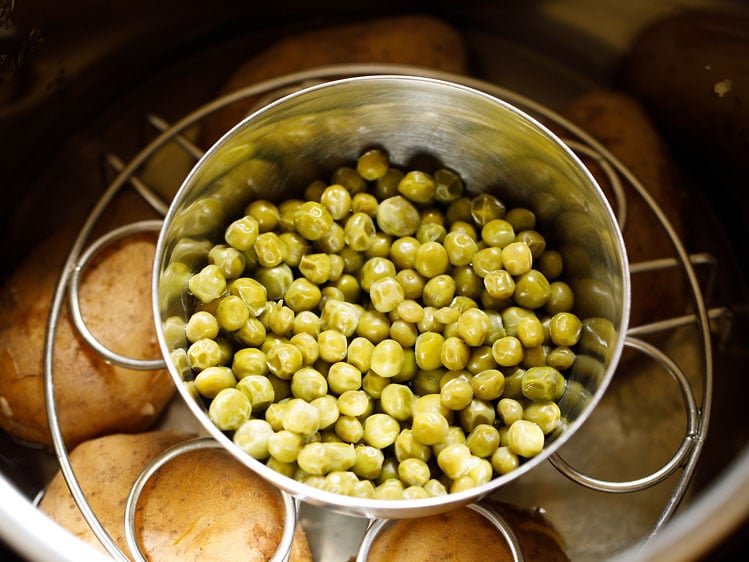
Spices: Roast and Powder
3. Roast or toast the spices after that. It is important to do this, as it will aid in releasing their flavors!
Add the following spices to a small frying pan set over low heat:
- A quarter-inch cinnamon stick
- One optional clove
- One green cardamom
- Three black peppercorns
- 1/4 tsp. cumin seeds
- 1/2 tsp. fennel powder
- Two teaspoons of coriander powder
Take care not to burn the spices as you heat them for a few minutes until they become fragrant.
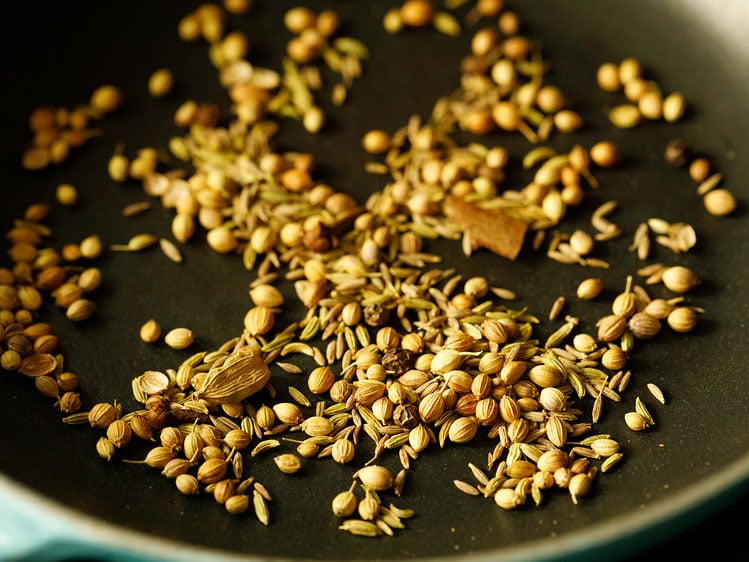
4. After taking the spices from the stove, let them cool fully. After that, transfer them to a small mixer-grinder jar or spice grinder.
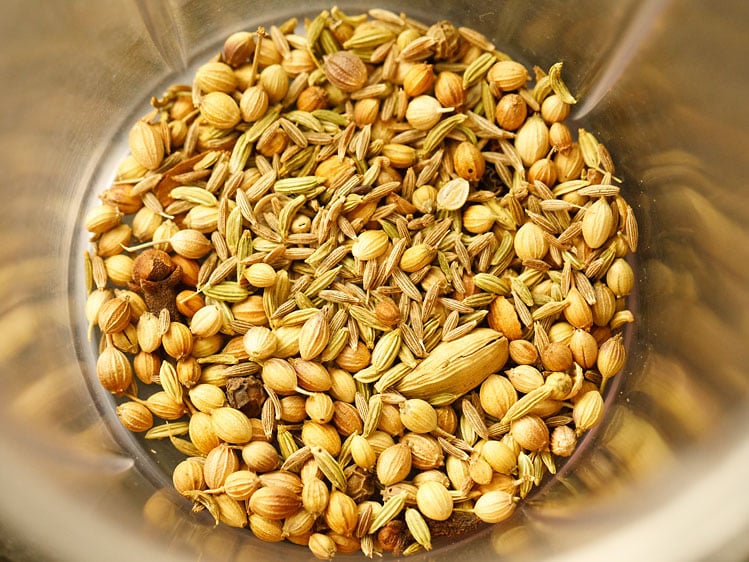
5. Pulse the roasted spices into a medium-sized powder and save.
Advice: I have an answer if you are short on time and cannot roast and grind the spices.
In a small bowl, combine 2 teaspoons ground coriander powder, ½ teaspoon ground cumin powder, ½ teaspoon ground fennel powder, and ½ teaspoon garam masala powder.
When the green peas and the other ground spices are added in step 9, add this prepared spice mixture.
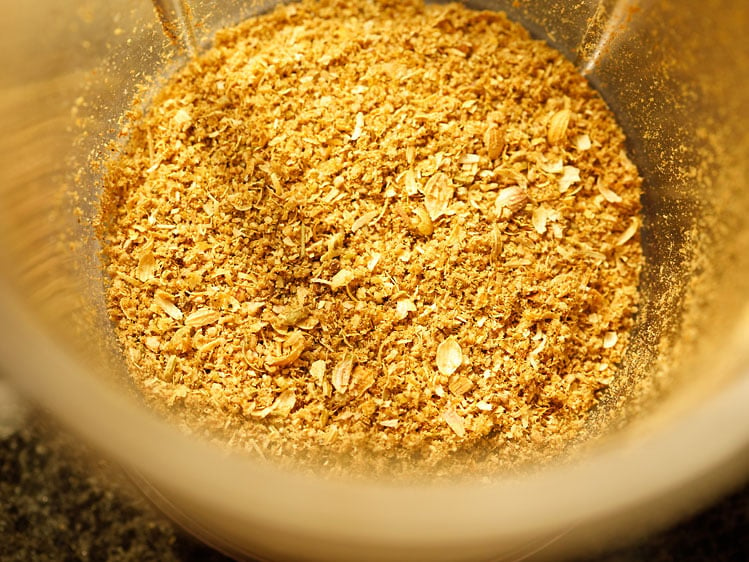
Prepare the potato stuffing.
6. After the potatoes have cooked, peel the skin and cut them into ½ to 1 inch cubes.
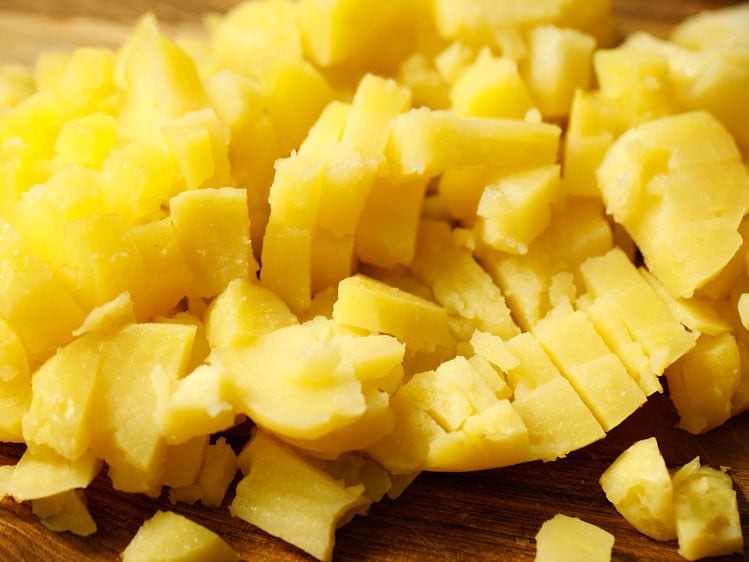
7. Heat one tablespoon of oil in a small skillet. Lower the heat to low after the oil reaches a medium temperature.
Toast one-half teaspoon of cumin seeds until aromatic. I chose mustard oil because it gives the stuffing a great punch.
Neutral oils such as canola, grapeseed, safflower, or sunflower oil may be used.
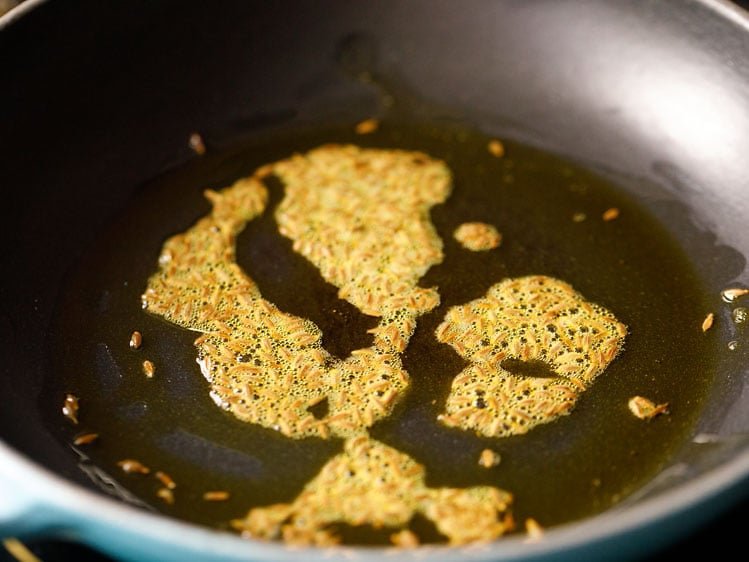
8. Turn down the heat to low and add 2 teaspoons of finely chopped green chilies and 1 teaspoon of minced or finely chopped ginger. Cook for a few seconds, or until the ginger loses its raw smell.
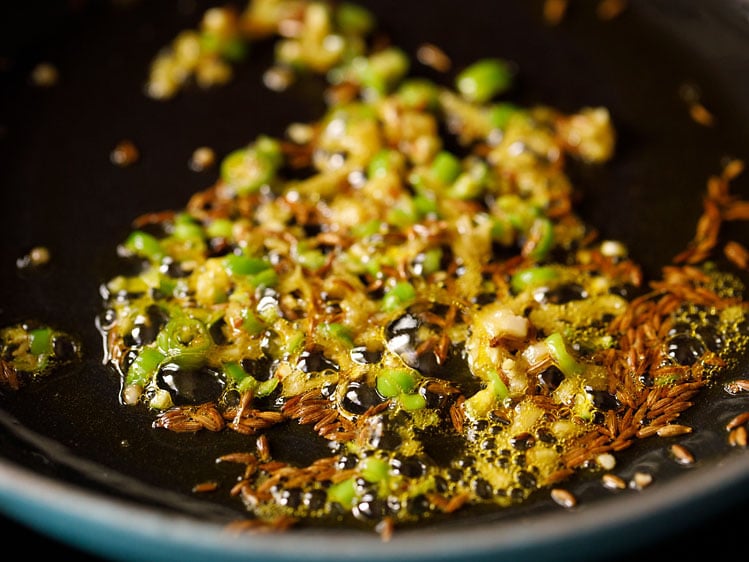
9. You may now turn the flame off or just keep it low. The cooked green peas, ½ teaspoon red chili powder, 1 pinch asafoetida (hing), our own dry ground spice blend, and 1 to 2 teaspoons dry mango powder (amchur) should all be added at this point.
The distinctive tangy taste of the Punjabi Samosa filling, which melds so well with the savory, spicy flavors of the other stuffing components, comes from the mango powder.
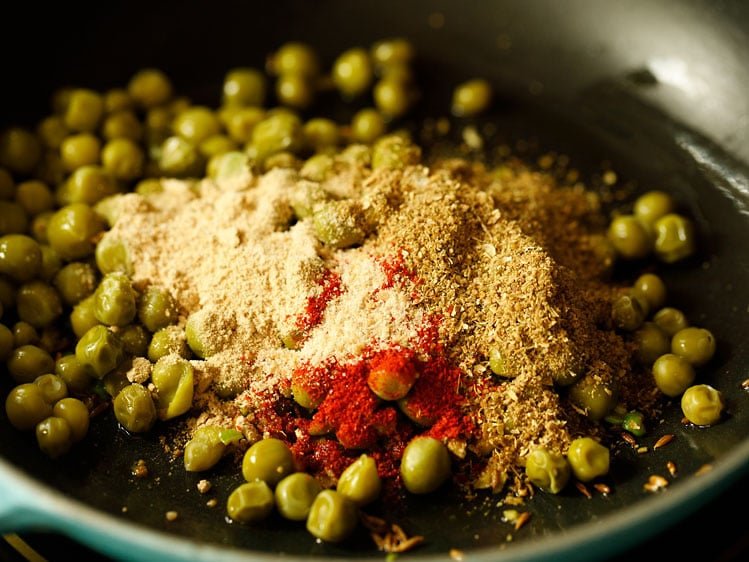
10. Mix well and cook for one minute. You may adjust the amount of dried mango powder to suit your taste.
I found that one teaspoon was not nearly enough sour taste, so I added two.
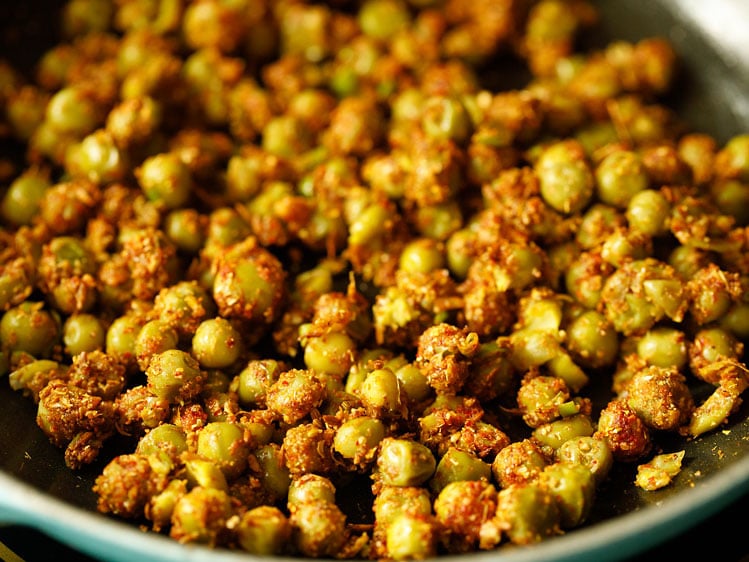
11. After that, add potato cubes, salt to taste, and one tablespoon of finely chopped coriander, or cilantro, to the pan.
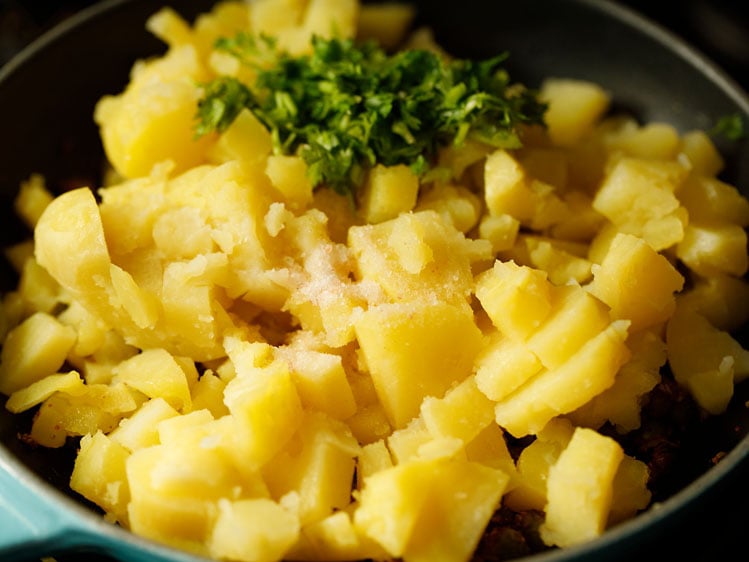
121. Stir well and cook for one minute. Taste and adjust with extra spices, salt, or dry mango powder if necessary.
While you prepare the dough, cover and set aside the filling.
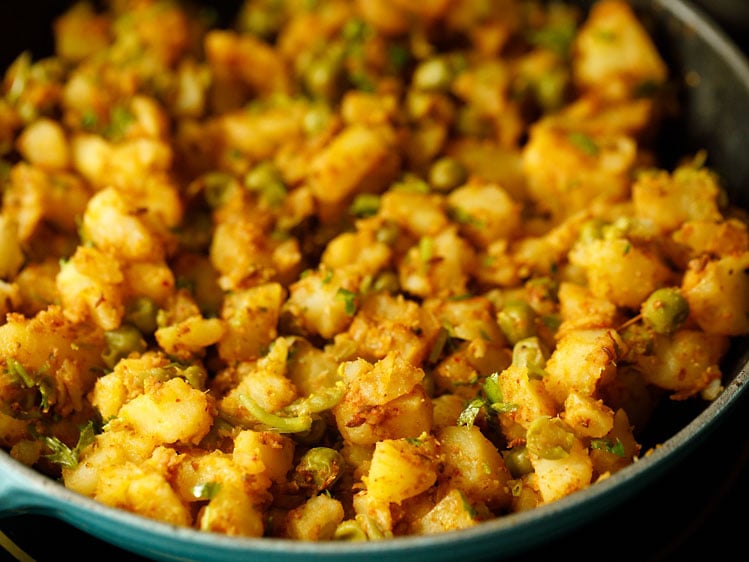
Prepare the dough for Samosas.
13. Mix together 2 cups (250 grams) all-purpose flour, 1 teaspoon carom seeds, 1 teaspoon salt, and 6 tablespoons (50 grams) ghee in a large measuring basin.
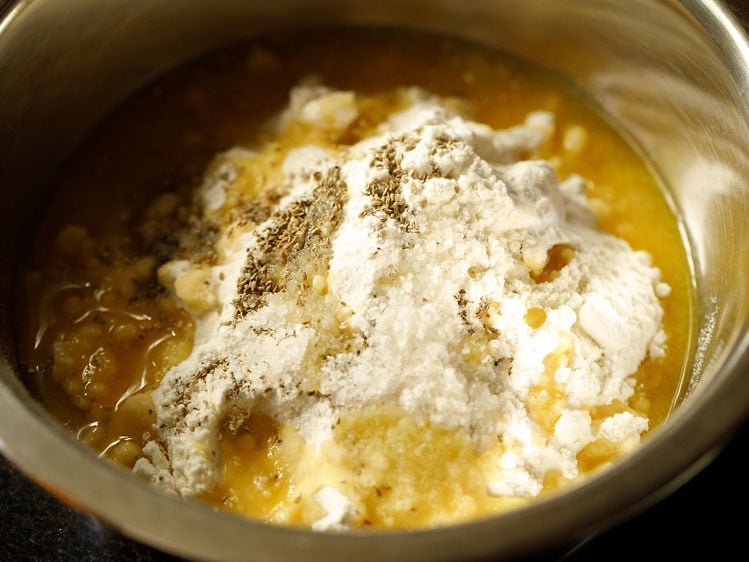
14. Work the ingredients into a texture that, when pressed, retains its form, like breadcrumbs, using your fingers to blend them together.
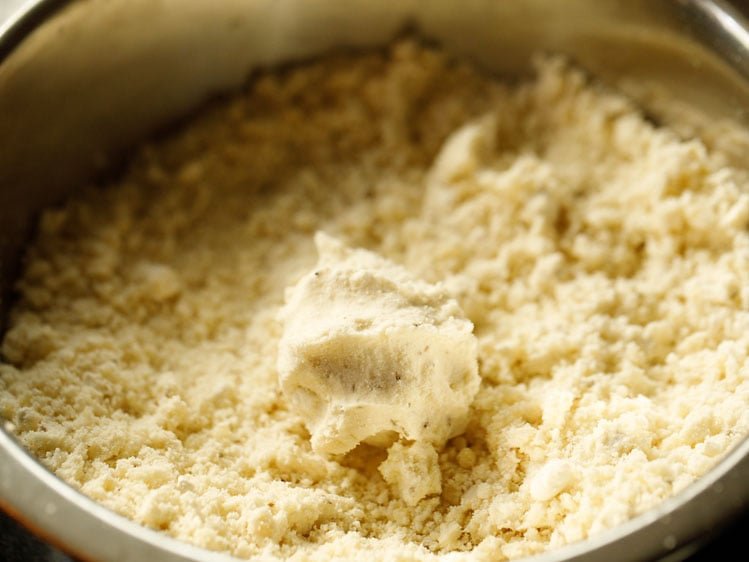
15. Next, gradually add 7 to 8 tablespoons of water and knead, a little at a time.
If the dough seems dry or floury, you may add an additional 1 to 2 tablespoons of water.
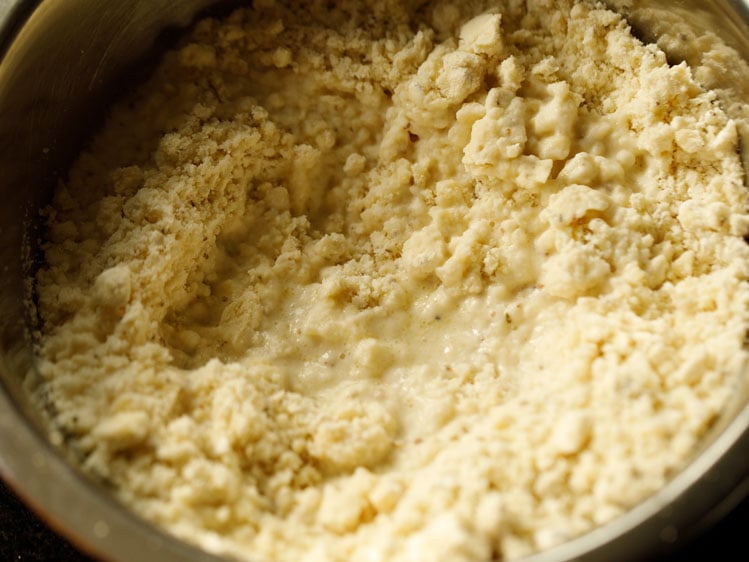
16. To create a compact, solid dough, keep kneading. It shouldn’t be sticky or soft. After covering the dough with a damp kitchen towel, let it rest for half an hour.
If the dough is too sticky or wet, add a few tablespoons of flour. Remix and knead until a solid dough is achieved.
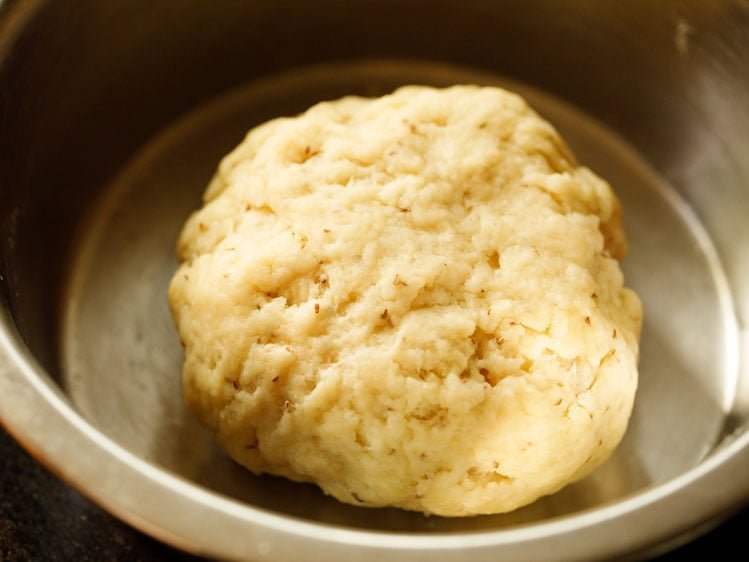
Put Together and Form
17. Divide the dough into six or seven equal pieces when it has rested. To smooth and soften each piece, roll it lightly in your hands first. Put it on the rolling board or in your work area.
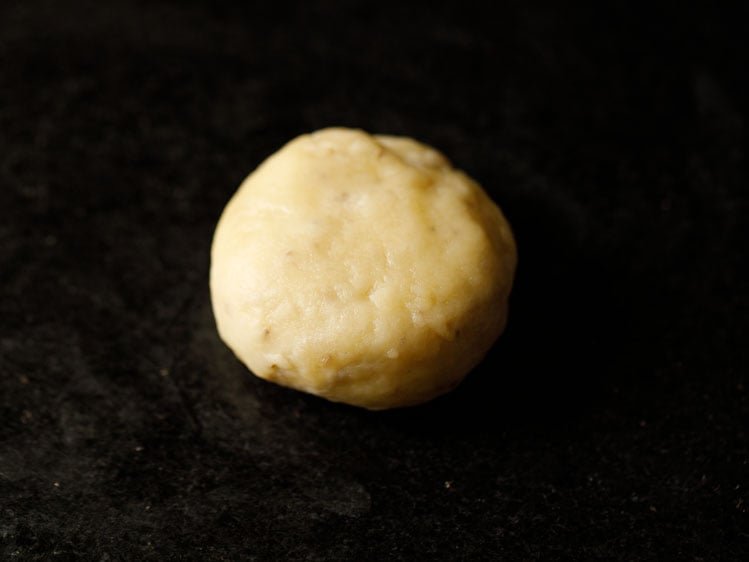
18. Next, use a rolling pin to roll it, taking care not to roll it too thinly but rather evenly to a thickness of 1 mm.
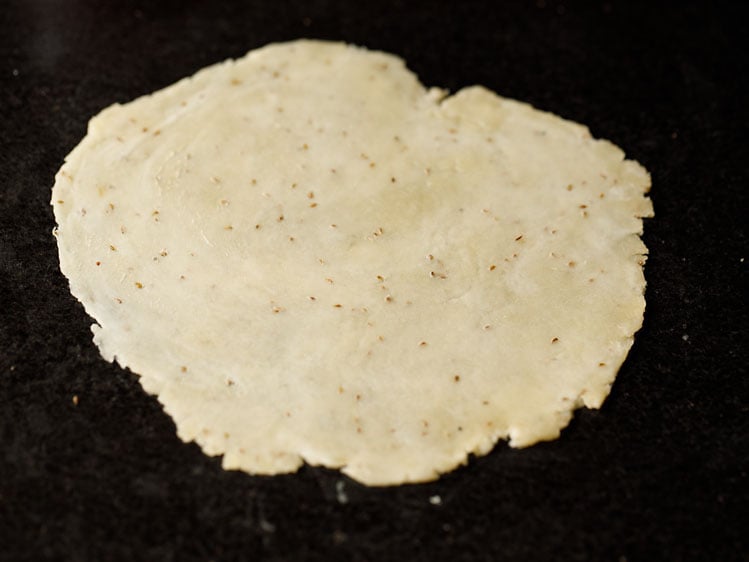
19. Cut through the middle of the rolled pastry dough with a knife or pastry cutter.

20. To make the half moon form even, lightly flatten it using a rolling pin.

21. Apply a thin layer of water to the dough’s edges with a pastry brush.
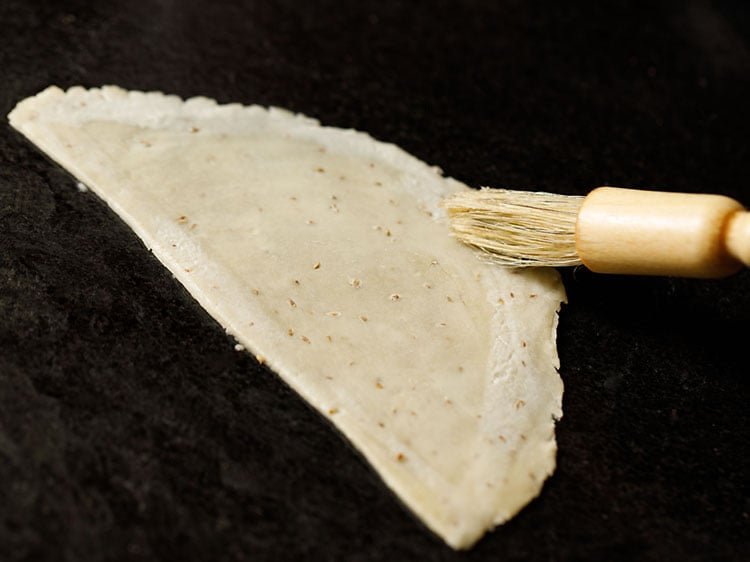
22. Then, fold to create a cone by joining the straight-edged sides together, as shown in the picture below. To ensure that the edges are sealed, be sure to press them firmly!
Now that the cone is prepared, the potato and pea filling may be added.
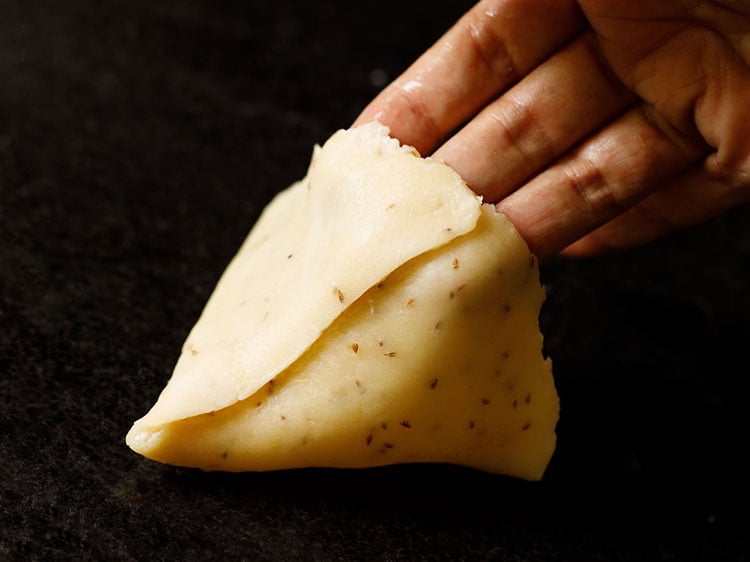
23. Spoon the prepared potato and pea filling into the cone, being careful not to overfill it.
In order to avoid the samosas popping during the frying process, be sure not to overfill or underfill.
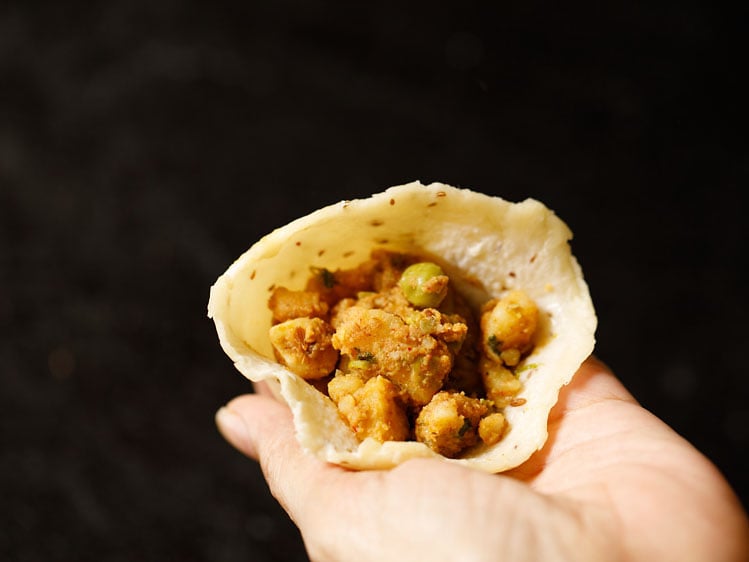
24. As shown in the picture below, crimp and squeeze the edges to seal. When the samosa is produced, this aids in its standing.
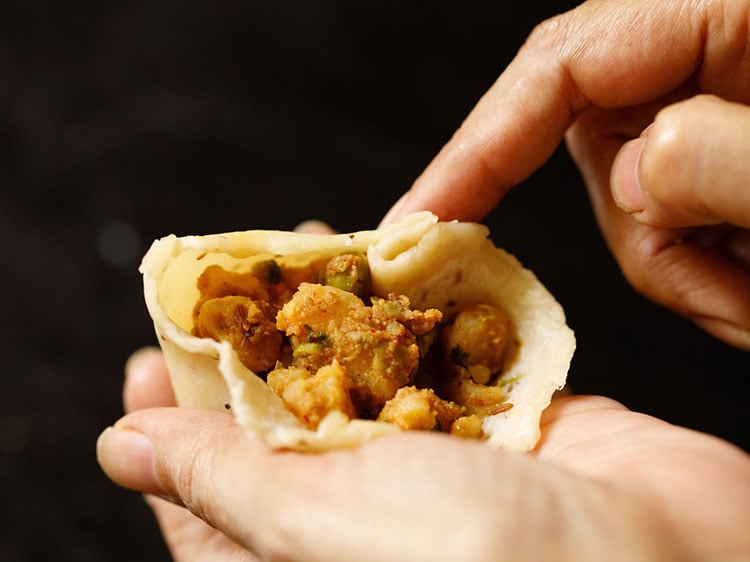
25. Make sure the dough is not cracked by evenly pressing all of the edges. To prevent the filling from escaping during the frying process, the sides must be wrapped very tightly.
Proceed with the preparation of each samosa as mentioned before, and to prevent them from drying out, cover them with a wet kitchen napkin.
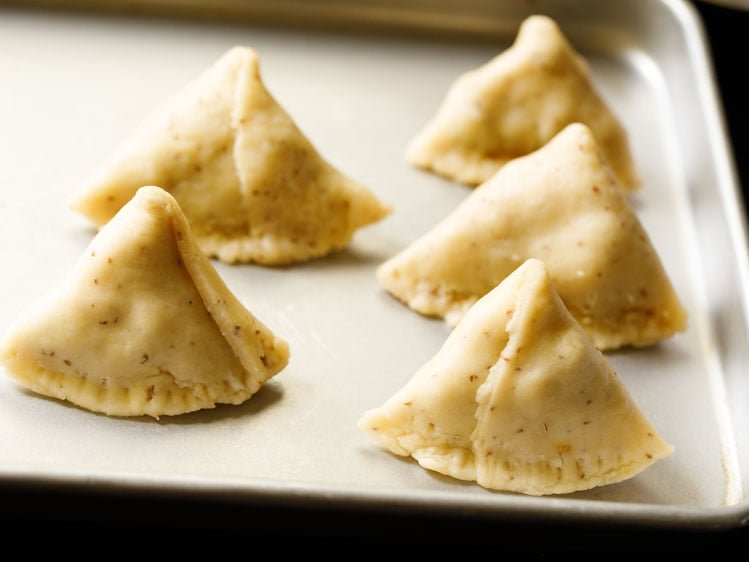
Deep Fry
Cooking them until they are a flawlessly crunchy golden brown is the last step in creating the greatest samosas.
You may deep fry with any flavor-neutralizing oil, such as sunflower, canola, vegetable, safflower, or grapeseed oil.
26. Warm up the oil in a pan or kadai before deep-frying. If the oil is heated enough to fry, test it by adding a little piece of dough, which should rise fast.
After the oil reaches a medium-hot temperature, carefully place three to four of the prepared filled samosas into it. Immediately after, turn down the heat to low.
To guarantee that they all fry equally, don’t pack the pan too full!

27. Make sure not to burn them by watching them as you fry them on low to medium-low heat.
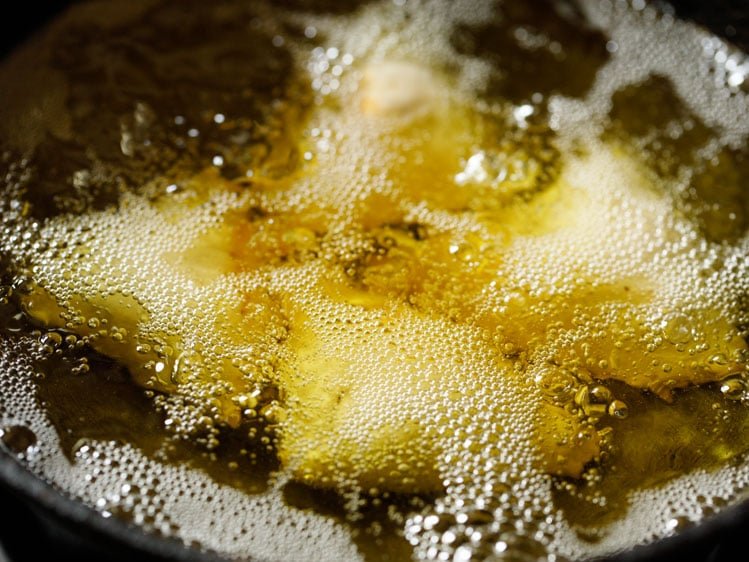
28. Use tongs, a slotted spoon, or a skimmer to carefully flip each samosa over and fry it until the other side is a light golden color.
In this manner, turning will be necessary a few times to ensure equal cooking. They are hefty and may leak oil, so turn them carefully and gently.
You must exercise patience and composure since frying them takes a long time!
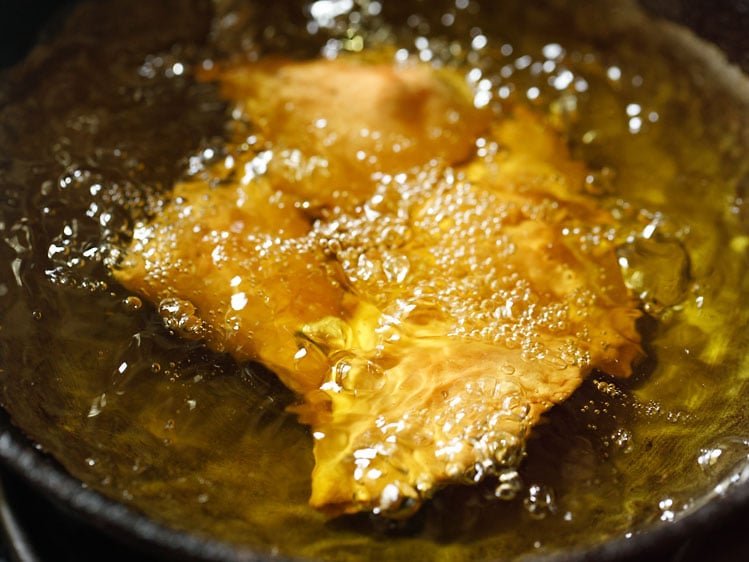
29. Fry each aloo samosa till it becomes brown and crisp. When the samosas are thoroughly cooked, the oil will no longer sizzle. They’ll have a lovely golden crispness.
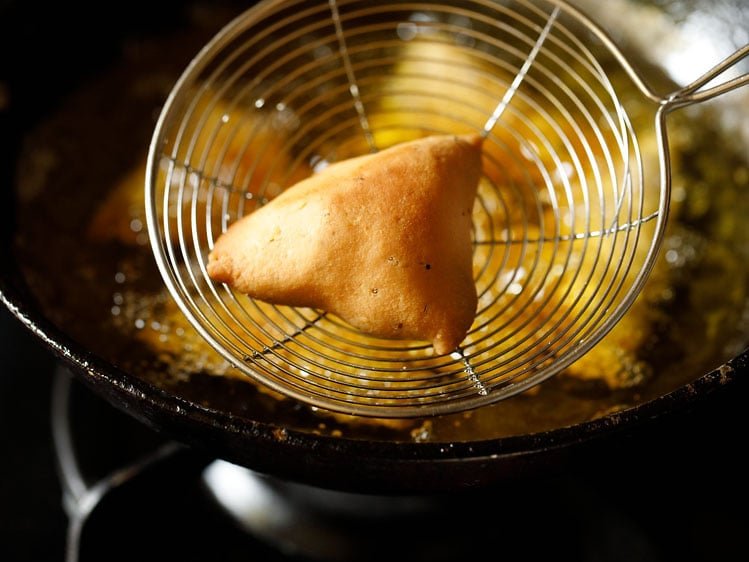
30. After gently removing the fried samosas from the oil using a skimmer spoon or spider spoon, set them on paper towels to drain any remaining oil.
Proceed with the frying process for the remaining Aloo Samosa batches. When you start frying the subsequent batches, turn down the heat. While the samosas are frying, adjust the heat as necessary.
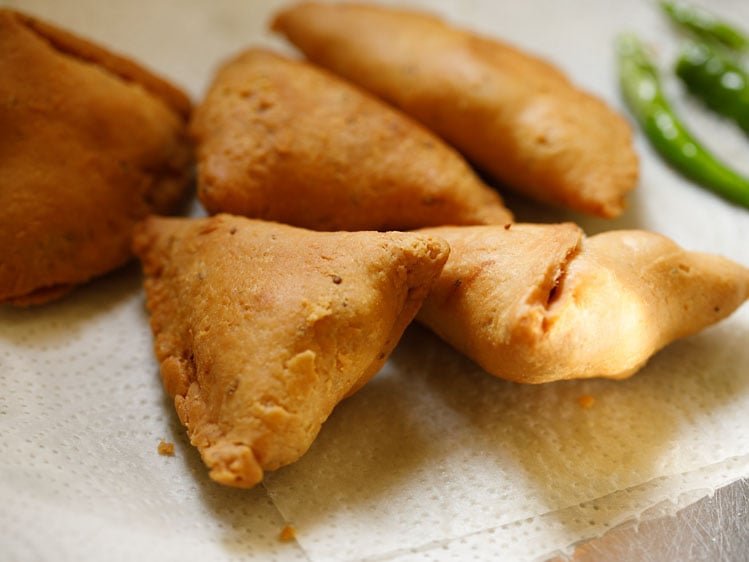
31. Serve Punj1.i Samosa warm, heated, or at room temperature with a tangy tomato ketchup or with coriander or tamarind chutney.
In India, the combination of Aloo Samosa with masala chai is highly favored and addictive.
They go well with chana masala as well. The name of this dish is samosa chole. Samosa Chaat is another well-liked chaat appetizer that is created using potato samosas.
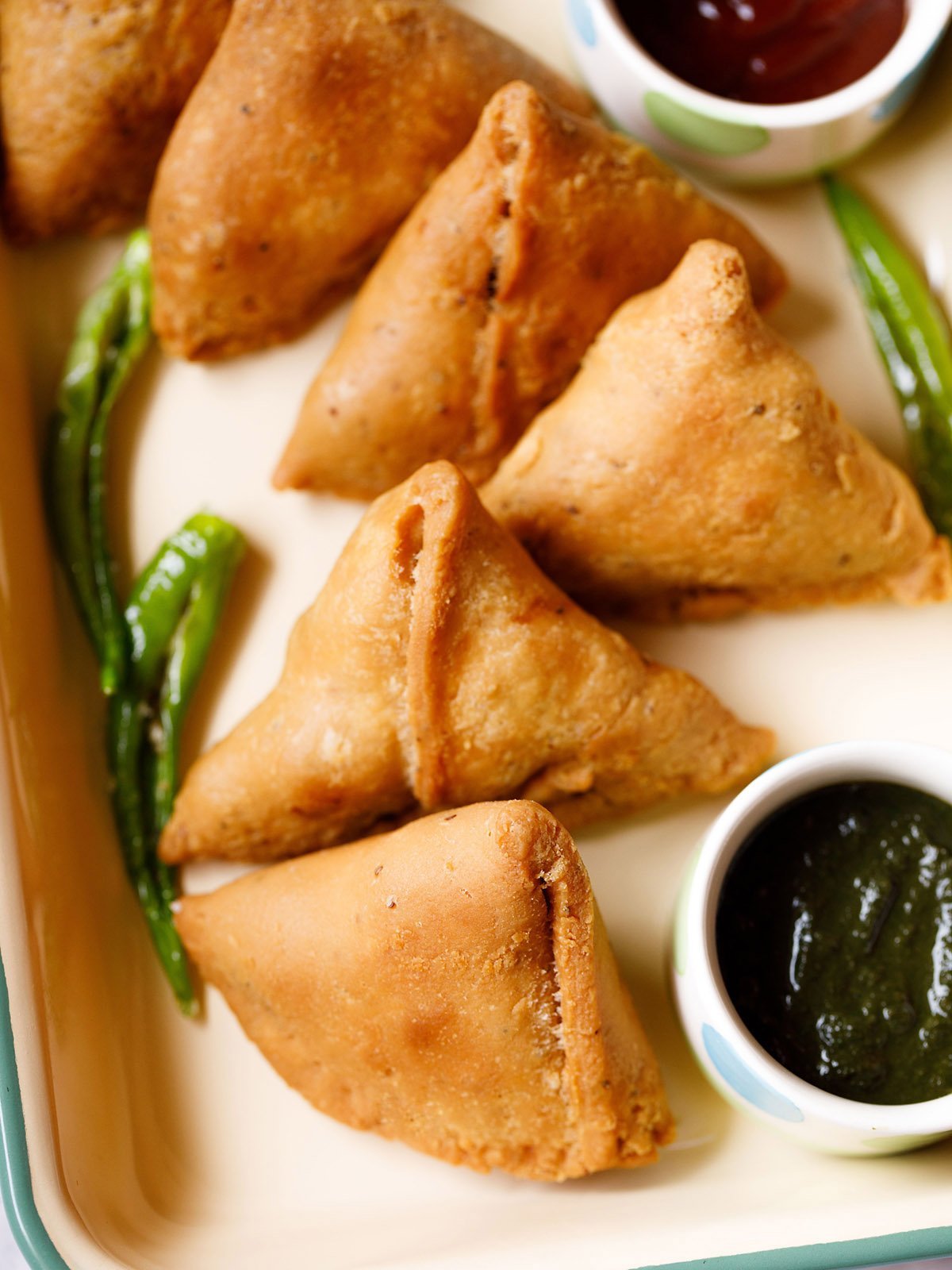
Various Samosa Stuffing Recipes
The filling for samosas varies greatly based on the state and area of India.
- Potatoes by themselves or in conjunction with peas are popular in Delhi and Punjab; neither the potatoes nor the peas are mashed or crushed. The potato cubes are cooked to perfection, yet they still have some chunks of green chili on the inside. Due to the use of dried pomegranate or mango powder, this stuffing has a somewhat acidic taste. There are also a couple extra spices added.
- Some versions of the samosa also include raisins, which add a sweet-sour flavor. For extra crunch, cashews are sometimes included as well.
- In some regions, the filling is completely mashed and heavily spiced.
- Fried green chilies are often served separately if they are not included in the filling.
- Additionally, some add ginger-garlic paste, and very seldom, I have also discovered chopped carrot pieces in the stuffing.
- There’s also a variant created with mixed veggies. Additions include potatoes, carrots, cauliflower, and peas.
- Another version is the onion samosa, which is stuffed with a spicy combination of onions and poha (flattened rice).
- A khoya (mawa), almond, and dried fruit filling is also used to make sweet samosas. Usually, this is created for holidays like Diwali or Holi. Other names for these samosas include dry fruit samosa and khoya samosa.
- Paneer cubes are added to the stuffing in another version.
- A cocktail samosa is a little samosa filled with a dry mixture of almonds, spices, and dried fruit.
Professional Advice
In order to get that flaky and crispy crust in the aloo samosa recipe, you may be wondering what the ideal component proportions and frying technique are. I dissect it thoroughly for you.
1. percentage of fat
The right quantity of fat, known as “moyen or moyan” in Hindi, must be included in the dough for samosas in the proper proportion. A buddy of mine who is very skilled in the kitchen often advises adding ⅕ of fat for every 1 part flour by weight.
Example: You need to add 200 grams of fat to 1 kilogram of flour. I used the same ⅕ ratio of fat in this recipe—50 grams for every 250 grams of flour.
2. percentage of water
The dough for the samosa crust has to be kneaded until it becomes firm and tight. The dough shouldn’t be as soft as that of bread or rotis. Thus, while kneading, use less water. The quality of the flour will determine how much water is added. Therefore, while kneading the dough, gradually add water.
3. Assembling samosa dough
The crust must be rolled out uniformly, maintaining a 1 mm thickness throughout. Avoid rolling the crust too tightly. A thick crust will need a lot of cooking time and have a tough feel.
Keep the dough from becoming too thin. It will explode in the oil and be unable to hold in the potato filling. Therefore, keep these suggestions in mind when you roll the dough.
4. Two methods for frying
There are two ways to cook a samosa to create the ideal crispy, flaky exterior.
1. Frying in a cool environment
The oil should first be heated to a medium-high temperature using this procedure. Finally, drop the samosa into the heated oil. As soon as you drop them into the heated oil, turn down the heat to medium-low or low and cook the samosas there.
By doing this, you can be sure they won’t absorb too much oil. The samosas absorb too much oil if you submerge them straight into less heated oil. When samosas are fried in very hot oil, little air pockets may develop on the crust, resulting in an undercooked inside.
2. Frying twice
If you have enough time, I recommend you attempt this somewhat more involved process while creating samosas. In order for the dough to seem cooked, the samosas must first be gently fried without allowing them to get brown.
When the crust is opaque and pale white, add the samosas to the heated oil and remove them. To ensure they don’t shatter when removed, fry them until they are only lightly browned. Put them away. After that, reduce the oil’s heat and continue to cook the samosas until they get brown.
Both approaches will provide samosas that are cooked through on the inside and have a crispy, flaky outside, similar to those seen in Indian candy shops, and their crusts will be free of air pockets.
How to use an air fryer to create aloo samosas
Make samosas in your air fryer, if you have one. The texture of the air-fried samosa will take you by surprise. With less oil, they do taste like the fried ones.
To begin air-frying, preheat the air fryer for 10 minutes at 180° C/356°F. When the samosas are golden, air-fry them at 180° C/356° F after giving them a quick oil brush.
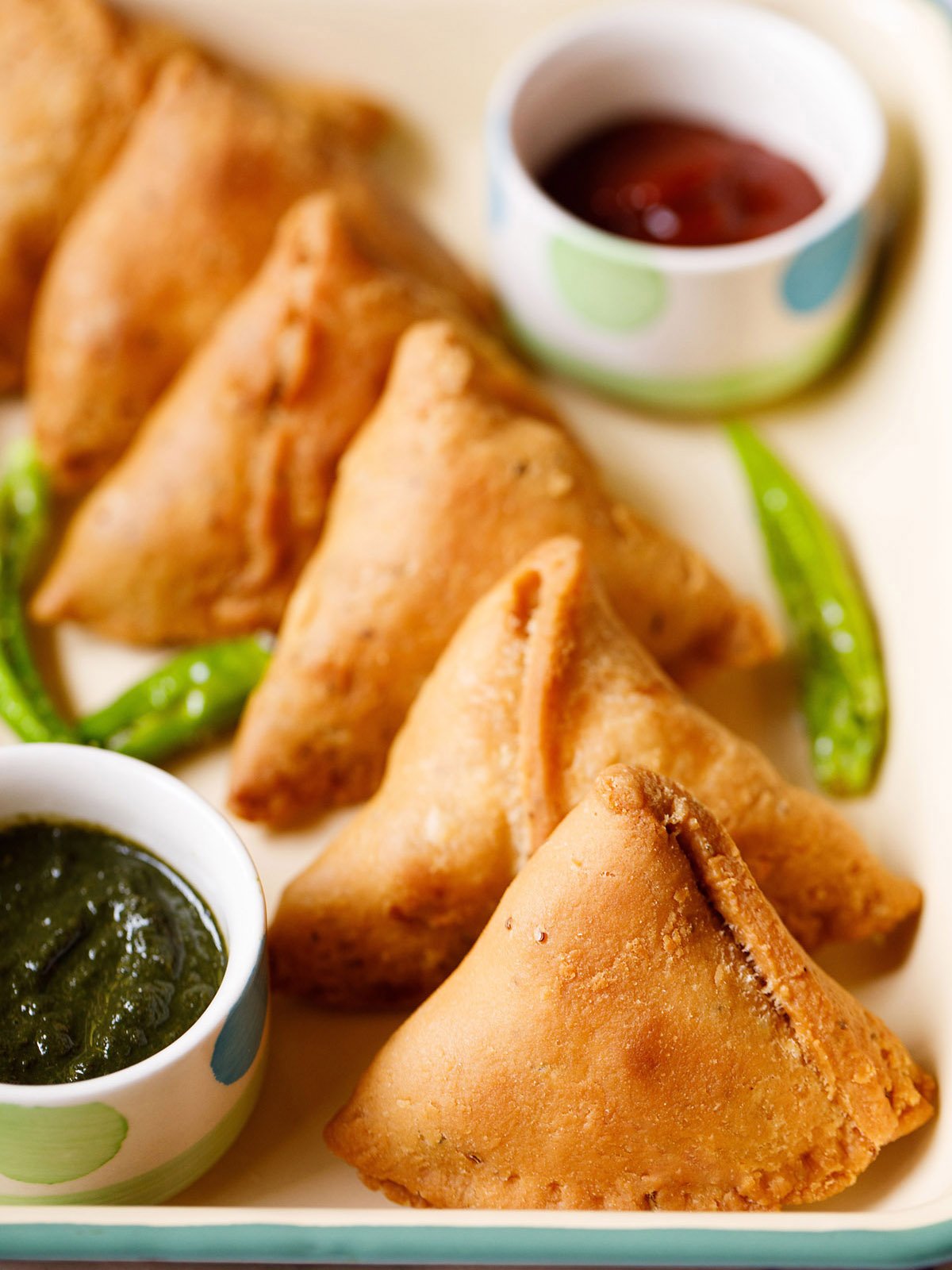
FAQs
Based on the questions readers posed in the comments, I have included the answers below.
Is it possible to create samosas with whole wheat flour?
You can do that, yes. In actuality, whole wheat flour might be simply substituted for all-purpose flour in a lot of Indian recipes. Just keep in mind that whole wheat flour absorbs more water, so add more while kneading.
But the crust created with whole wheat flour may become thicker and less flaky than that made with all-purpose flour.
I don’t possess an amchur. Anything in its place?
One teaspoon of lemon juice should be added to the potato filling. Add two tablespoons of dried pomegranate powder if you have any.
Samosas, can I freeze?
They are freeze-able. You may either form them before freezing them or you can fry them until the crust becomes opaque before freezing them. They will continue to improve in this manner.
Allow the samosas to come to room temperature before frying. They absorb more oil if they are fried when they are still cold.
Why do the air pockets on my samosa look like this?
While a few air pockets are OK, there shouldn’t be many covering the outside of the of the fried crust. The crust will have air pockets if the dough is soft.
An excessive amount of moisture in the dough gives the crust a soft texture and plenty of air pockets. When frying, air pockets form on the crust if the oil is too hot.
Can I use phyllo, puff pastry, or spring roll wrappers to create samosas?
1. Bake the samosas if you’re using puff pastry sheets. Air fryers are also an option.
2. You may either fry or bake the spring roll wrappers.
3. Bake them on phyllo dough sheets.
Are onions allowed in the stuffing?
Authentic Punjabi samosa recipes often do not use onions or garlic. However, we can always be inventive and create our own versions. Thus, if you’d like, you may add garlic and onions.
Garlic and onions both significantly alter the stuffing’s flavor. In fact, there is a variation known as onion samosas, which is a well-liked street snack in which onions are the main component in the filling.
Why did my fried samosa become mushy and dripping wet?
Two factors may cause samosas to soften. When frying, either the oil is too cold or the dough is too soft.
Make sure the dough is hard and tight as you knead it. It shouldn’t be as tender as the dough for bread or rotis.
What’s the recipe for the Punjabi Samosa that is served with fried green chillies?
Slitting the green chilies without breaking them apart is the first approach. Fry them in a shallow or deep fryer until you see a few light, golden blisters.
Afterwards, add a little salt and stir into the cooked green chilies. Additionally, you may add some amchur powder or chaat masala.
The second technique involves stuffing slit green chilies with a combination of salt and amchur powder, or dried mango powder. Fry them shallowly and serve.
For how many days can I keep samosas?
It is readily stored at ambient temperature for a few hours. If you have no intention of eating them, keep them in the refrigerator in an airtight container (dabba). You may reheat them in an oven or on a tawa before serving.
How should I use any leftover samosas?
Serve them warm with bread, pav (dinner rolls), or roti by heating them on a tawa (griddle) or in a preheated oven to 170° Celsius. Samosa chaat, a delicious Indian street snack, is a terrific way to use them up.
What is the recipe for vegan samosas?
Indeed. When preparing the dough crust for a vegan samosa, use a neutral-tasting oil for the ghee (clarified butter).
Are samosas safe to air fry?
You can, of course, air-fry them. Kindly read the section on air-frying that I previously mentioned.
Are aloo samosas bakeable?
Yes, without a doubt. Preheat the oven to 180° C/356°F. Bake for 30 to 35 minutes, or until the crust is golden and crisp. Before baking, preheat the oven for ten minutes at the same temperature.




